Crochet Hook Sizes – Everything You Need to Know About Sizing + Cheat Sheet
Whether you’ve only just picked up a crochet hook for the first time or you’ve been crocheting for years, you’ve probably thought at some point that crochet hook sizes are confusing.
There’s no debate here… They ARE confusing. With different countries using different labels for their crochet hook sizes, it can feel like you’re swimming in a sea of letters and numbers with no life raft.
Let’s remove the confusion of crochet hook sizes and break down what the sizes mean, when you might use a certain size, what size of crochet hook is best for beginners and more.
Plus, you’ll get a free printable cheat sheet in this post so you can always have a guide with you!
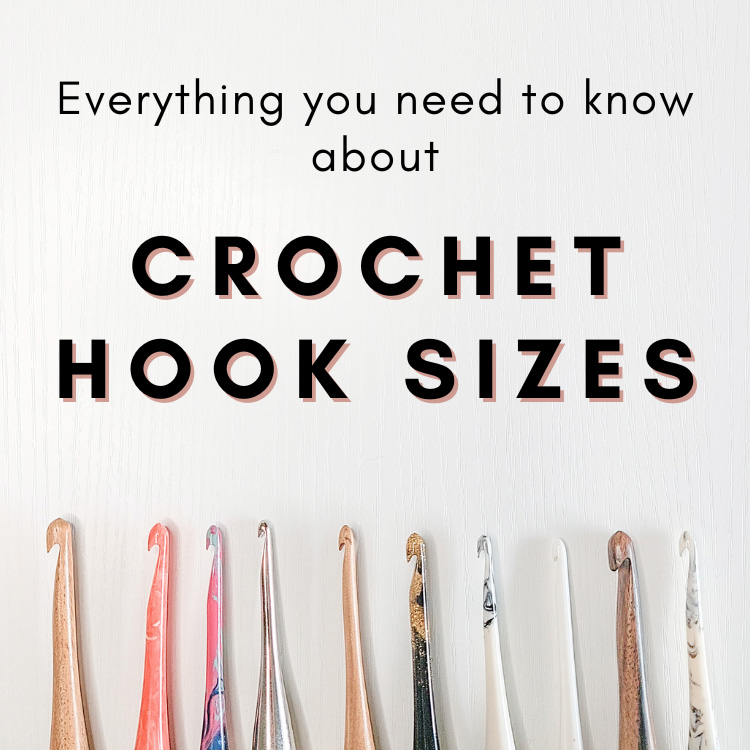
DISCLAIMER: This post includes affiliate links. This means, should you decide to purchase a product via one of these links, I will receive a small commission at no extra cost to you. I only recommend products I use and love (Or products I know others love, have heavily researched, know have good ratings and plan to purchase myself). These small commissions help to support this blog and continue keeping most of my patterns free. You can read more on my Privacy Policy, if you prefer.
What is a crochet hook?
First things first, we need to know what a crochet hook even is before we talk about crochet hook sizes.
To say it simply: a crochet hook is your most used tool when it comes to crochet. A crochet hook is what makes crocheting possible.
A crochet hook is a long, thin object, similar to a pencil, with a hook on one end that you hold in your hand and maneuver through and around yarn to create stitches.
While they are sometimes mistakenly called “crochet needles”, likely because crochet is a cousin to knitting in which you would use knitting needles, they are not needles. The hook on one end is what makes it a crochet hook, not a needle.
The hook is used to insert into stitches, grab the yarn (by using the hooked end), and pull the yarn through.
Different sizes of crochet hook will yield different results and it’s important to know what those results might end up being.
Crochet Hook Anatomy
Just like knowing what a crochet hook is, we also need to at least understand the basics of crochet hook anatomy before we start talking about crochet hook sizes.
The anatomy of the hook directly relates to the crochet hook size.
While you can go forth and crochet without understanding the anatomy of your hook, it’s important to know why the size of the hook changes anything and where to measure your hook if the hook doesn’t have a size listed.
All crochet hooks have the same general layout. From there, they branch off into different types of hooks, grips and materials.
General Crochet Hook Anatomy
Regardless of style, each crochet hook is going to have the same general layout of anatomy.
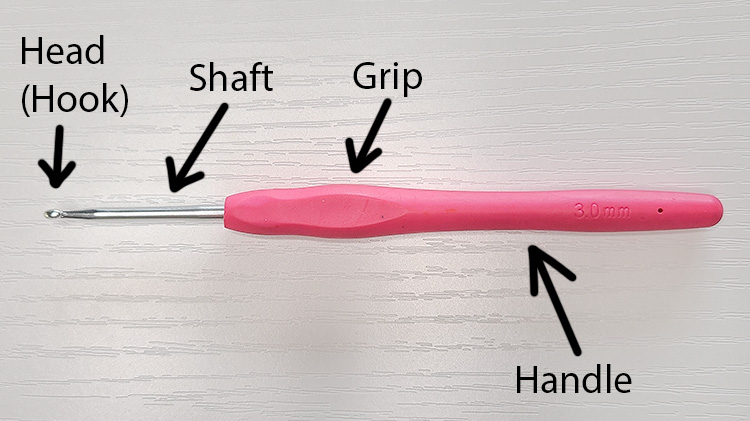
Styles will change how these specific parts look but each hook will have the following parts:
- Handle: Where you actually hold the hook. Styles of handle vary greatly depending on brand or type. For example, Furls Crochet Hook handles are teardrop shaped so you don’t have to hold the hook as tightly. Tulip and Clover are brands that have high quality aluminum hooks with hard rubber grips to make them more comfortable to hold. Aluminum only hooks typically have a thumb rest in which the handle is indented or shaped for your thumb.
- When it comes to choosing a style of handle, it’s important to test different types out to see which works best for you. There’s no one size fits all style.
- When it comes to choosing a style of handle, it’s important to test different types out to see which works best for you. There’s no one size fits all style.
- Shaft: This is the part of the hook that controls how big or small your loops are and therefore determines your gauge and tension.
The shaft is the part of the hook between where you grip the hook and the actual hooked part of the tool.
The shaft is the direct correlation to the size of the hook because the shaft’s millimeter diameter IS the size of the crochet hook. - Head (or hook): Sometimes also referred to as the point or tip of the hook, this is the part of the tool which is designed to grab and manipulate the yarn. The head includes:
- The point: top of the hook which we insert into stitches
- The throat: leads from the shaft to the tip of the hook
- The lip: The part of the head which actually creates the “hook” shape and is used to grab the yarn
- The bowl: Where the yarn rests once hooked by the lip.
- The head style can be different depending on whether you have an inline hook or a tapered hook.
- The point: top of the hook which we insert into stitches
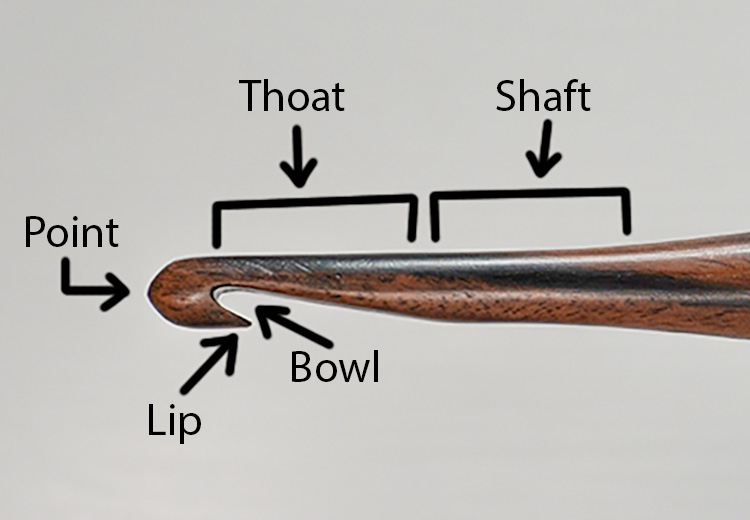
Inline vs Tapered Hooks
There are three main types of shape for the head of the crochet hook and which you use depends entirely on your preference.

Inline Crochet Hook means that the hook (head/point/tip) is directly in line with the shaft. This means you could draw a straight line from the shaft to the lip of the hook.
These hooks typically have deeper throats and sharper lips and points.

Tapered Crochet Hook means that the hook (head/point/tip) is NOT in line with the shaft. It can be either lower or higher than the shaft, though typically it sticks out beyond the shaft, and typically it has rounded points and shallower throats.

Hybrid Crochet Hooks are a mix of both an inline hook and a tapered hook. They take the best of both styles and combine them into one.


Crochet Hook Sizes
Crochet hook sizes are easily the most confusing part of this tool.
While anyone can pick up any crochet hook and use it with nearly any yarn, the size of the crochet hook is important for your project to turn out the way you want it to.
The reason crochet hook sizes are confusing is because the “label” is varied depending on the country you live in (or grouping of countries, like Europe).
You’ll see some crocheters referencing a letter size and some a millimeter size. It’s easy to feel confused and even frustrated by this.
There are 2 main ways crochet hook sizes are referenced: In US Sizes (shown with a letter and sometimes with a number with a hyphen or slash between them) or in metric sizes (shown in millimeters). Some crochet hook sizes are referenced in UK sizes, though that’s becoming increasingly uncommon.
In the US, it’s becoming more and more common for hook sizes to be referenced by both their metric millimeter size and their US letter size, though that’s not always the case.
And to make it even more confusing, some yarn labels will only reference hook sizes in their US letter and/or number, not in millimeters or vice versa.
Crochet Hook Size Chart
So, what are the sizes of crochet hooks? In the chart below, you can find all the sizes in millimeters and their equivalent US and UK sizes.
Sizes with (*) next to the millimeter size are most commonly used. Sizes with (x) next to the millimeter size are not commonly used. Sizes without any additional markings next to the millimeter size do exist and are used but not quite as often as the sizes with (*) next to them.
| Millimeter (Metric) Size | US Size | UK Size (Not Commonly Used) |
|---|---|---|
| 2.25 mm | B-1 | 13 |
| 2.5 mm | ||
| 2.75 mm | C-2 | 12 |
| 3 mm (*) | 11 | |
| 3.25 mm | D-3 | 10 |
| 3.5 mm (*) | E-4 | |
| 3.75 mm | F-5 | 9 |
| 4 mm (*) | G-6 | 8 |
| 4.25 mm | G | |
| 4.5 mm | 7 (sometimes referred to as G+) | 7 |
| 5 mm (*) | H-8 | 6 |
| 5.25 mm | I | |
| 5.5 mm (*) | I-9 | 5 |
| 5.75 mm | J | |
| 6 mm (*) | J-10 | 4 |
| 6.5 mm (*) | K-10.5 (or K-10 ½) | 3 |
| 7 mm | 2 | |
| 8 mm | L-11 | 0 |
| 9 mm | M/N-13 | 0 |
| 10 mm | N/P-15 | 0 |
| 11.5 mm (x) | P-16 | |
| 12 mm (x) | ||
| 15 mm (x) | P/Q | |
| 15.75 mm (x) | Q | |
| 16 mm (x) | Q | |
| 19 mm (x) | S | |
| 25 mm (x) | T/U/X | |
| 30 mm (x) | T/X |
Notice how the US and UK sizes jump around?
The US sizes especially can be confusing. Several hook sizes have the same letter, they may have several letters, they may not have a letter at all, and may switch completely to a number (looking at you, 4.5mm!).
Which unit of measurement should I use? Metric, US or UK?
The unit of measurement you use to refer to your hooks is completely up to you. There is no right or wrong unit of measurement.
Personally, I find the millimeter size to be much easier to understand and follow. I also recommend that beginners learn hook sizes in millimeters as opposed to US sizes. Here’s why:
Millimeter sizing just makes logical sense. Millimeters are a unit of measurement, not an ambiguous label.
“B-1”, “C-2” and so on are labels. We couldn’t use a ruler to measure what “B-1” means. If you didn’t already know that “B-1” should directly correlate to 2.25 millimeters, you’d never know what the size label meant.
Think of this like the difference between men and women’s jeans. In the US, men’s jeans come in inches, a unit of measurement. A size 32 in inches is going to be a size 32 in inches regardless of brand.
Women’s jeans? They’re labeled sizes, not a unit of measurement. A size 10 here might be a size 12 there and might even be a size 14 somewhere else. It’s not an accurate unit of measurement and, if you’re a woman in the US, I would bet you’ve been frustrated by clothing labels like this before.
This example of jeans is to show that an actual unit of measurement is much easier to understand and much easier to feel confident in or measure across brands than a label is.
It just makes sense that 5 millimeters will be bigger than 4 millimeters. I don’t need to remember that 5 mm is “H-8” or that there is an I hook between H-8 and I-9.
Additionally, some hook sizes only have millimeter sizes, like 3mm, 7mm and 12mm. While these hooks aren’t quite as commonly used, they are still used and it doesn’t make sense to have to use two totally different units of measurement just because it’s not included in a US sizing structure.
Of course, the lack of US size labels for certain millimeter sized crochet hooks is most likely because these sizes of hooks, specifically the much larger sizes, are more modern. As crochet continues to be a hobby people enjoy, it makes sense that it will become more modern and more sizes will become available.
This also means that more millimeter sized hooks will be available without a US or UK specific size label, which also adds to the confusion.
None of this is to say that what you call your hook size is wrong. It absolutely isn’t!
This is to show how and why using different units of measurement for hook sizes is confusing and why having a cheat sheet available can drastically help alleviate that confusion and/or frustration.
Downloadable and Printable Crochet Hook Size Cheat Sheet
If you’re thinking that it would be awfully nice to have a crochet hook sizes chart that you can download, print and reference instead of constantly Googling it, you can download my crochet hook sizes chart!
The chart is a single page and includes highlights for the most commonly used crochet hook sizes as well as highlights for sizes that are not as commonly used.
Something to note about hook sizes that don’t use mm as their unit of measurement…
It’s been heard on the grapevine that some crochet hook manufacturers have started using different letters for sizes that do not match what most crocheters know of US sizes.
While I haven’t specifically run into this myself, it absolutely does not surprise me in the slightest to hear about it.
This could be a huge deal and cause a lot of frustration.
If you’re looking into purchasing crochet hooks, whether singular or as a set, you might consider checking the US letter label against the Craft Yarn Council to make sure you’re actually getting the sizes you think you are.
This is another reason why I personally think millimeters are the superior unit of measurement for me. Manufacturers can’t really play around with millimeter sizing so they’re going to be accurate to what you expect.
Where to find the size on a crochet hook
Most of the time crochet hooks have their size either printed, engraved or embossed (printed lettering that lifts up versus being engraved) on the handle.
These are typically either at the end of the hook opposite from the tip or in the middle of the handle. Sometimes, the size can be found printed on the very bottom of the hook opposite the tip, but this isn’t quite as common.
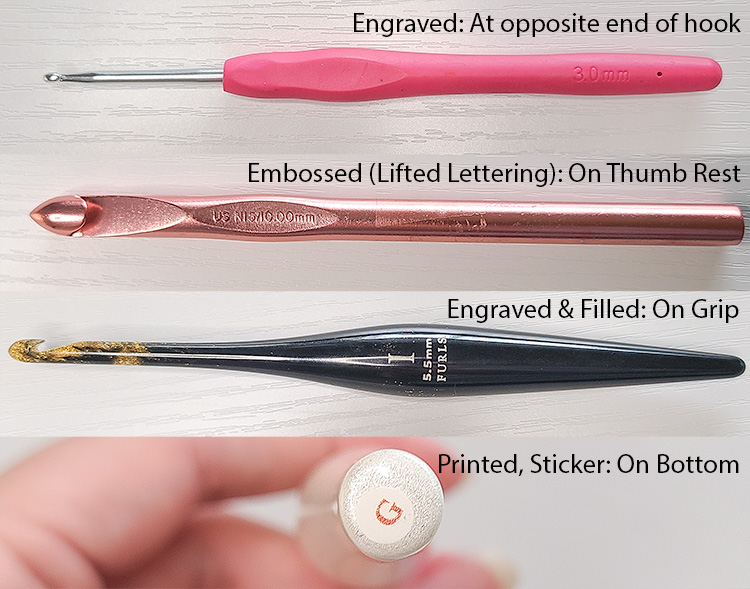
How to measure a Crochet Hook to determine the size
You may have crochet hooks where the printed size label has rubbed off or perhaps you’ve inherited some lovely hooks from grandma that don’t have sizes on them at all.
In this case, you need a way to figure out exactly what the size of the hook is before you start using it.
Since we’ve gone over crochet hook anatomy, we know that the shaft of the hook is where the size is determined.
Regardless of if you are using Metric, US, UK or any other sizing, the actual size of the hook is always determined by the diameter of the shaft in millimeters.
This means that we need to determine the diameter of the shaft of the hook in millimeters to know its size.
To do this, we can use a Hook Gauge Tool. These can also be referred to as Knitting Needle Size Tools but they are the generally same thing.
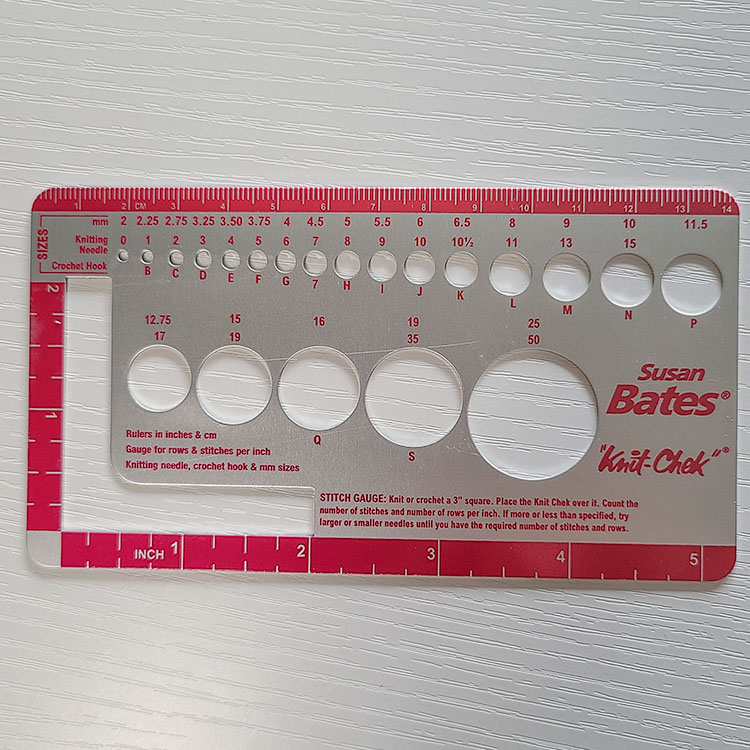
These tools come in many sizing formats from Metric to US sizes (or both), and materials from wood to plastic to metal. I recommend getting a tool that has both the US and Millimeter sizes if you aren’t already used to millimeters.
The tool will have either several circular holes inside the material or have half oval shaped cut outs from the sides of the tool. Regardless of the type of cut out (holes or half ovals), they’ll be labeled with the size.
Personally, I prefer a hook gauge tool with the half oval cut outs for crochet hooks. Especially if you prefer tapered style hooks or you have hooks that have ergonomic handles, the circular cutouts can be a little fiddly to use or not usable at all despite the hook being the correct size.
To use this tool, you will insert your hook into the holes or cut outs until you find the one that best fits the hook. This means that the hook can go inside the hole smoothly without force but is fairly snug.
Once you find the hole or cut out that fits your hook properly, you’ll know the size of hook you have!

- Picture 1: The hook is too big to enter the 6mm (J-10) circle, so it is bigger than 6mm.
- Picture 2: The hook fits into the 8mm (L-11) circle and is snug. This means this crochet hook size is 8mm (L-11).
- Picture 3: The hook clearly fits into the 11.5mm (P-16) circle but it has significant extra space. This hook is smaller than 11.5mm (P-16).
- Picture 4: A tapered 8mm (L-11) crochet hook is attempting to fit into the 8mm (L-11) circle. This hook IS 8mm (as printed on the hook and tested with a half oval cut out style tool) but it does not fit into the hole.
- This is because the hook is tapered and the lip sticks out further than the shaft does. This makes it appear as if this hook does not fit this circle.
- Remember: The size of the hook is determined by the shaft of the hook, not the shape or style of the head. This is important to note when it comes to tools like this because it could be very confusing to not have a hook fit a size you KNOW it should fit.
- This is why I would recommend a Hook Sizing Tool with the half oval cut outs on the side.
- This is because the hook is tapered and the lip sticks out further than the shaft does. This makes it appear as if this hook does not fit this circle.
Does the Material of my Crochet Hook Matter?
Crochet hooks come in a few different materials. Generally, the type of material you choose for your crochet hook is your preference.
Crochet hooks can come in several different materials, including:
- Aluminum: These hooks are commonly used across the board. Aluminum is a fairly cheap metal that is decently strong, so these hooks often come as sets but can be found as stand alone.
Aluminum hooks vary in quality, so it’s worth it to invest in more expensive aluminum hooks. Aluminum hooks that are cheaper can have imperfections that can snag and fray the yarn. Typically crocheters use aluminum hooks with the added hard rubber grip to help with hand pain. - Plastic: Plastic hooks are fairly easy to find anywhere you might shop for crochet hooks. These hooks are very light weight, which makes them a good choice for crocheters with wrist injuries that inhibit holding heavier weights. This material is usually popular for the very large crochet hook sizes as it’s a cheap material, which keeps the cost of these large hook sizes down.
Like aluminum, plastic crochet hooks can vary in quality, so make sure to check for seams or imperfections when buying plastic hooks. Depending on the hooks and the size, the lip of the hook can snap off if you have very tight tension. - Resin: Though they’re often lumped into the “plastic” category, resin hooks are more like a cousin to plastic. These hooks are generally more expensive, which directly relates to the higher quality of hook. These hooks glide well with any type of yarn but may be a little too slippery for beginners, making it difficult to practice even tension.
The major con for resin hooks is that the lip of the hook can snap off in the much smaller crochet hook sizes, though I personally haven’t had this happen and I’m a very tight crocheter. - Wood: Wooden hooks have fantastic grip that work well with any yarn but especially slippery yarn. This means they glide less smoothly through the yarn, which helps keep your tension when working with very slick yarn. Additionally, wood hooks are well known for being warm when held.
- Bamboo: Bamboo hooks fall into the same sort of category as wood, though it’s been said that their friction lessens with use. These could be a good option for beginners who are comfortable with spending a little more on a starter set. The friction in the beginning helps to keep the yarn on the hook and as this friction becomes less, you’ll naturally become comfortable with hooks that provide more glide like resin, plastic or aluminum.
- Steel: Steel hooks are typically used for the smallest of crochet hook sizes because steel is incredibly strong. In fact, steel hooks are usually even smaller than the crochet hook sizes listed above. This is because they’re typically used with thread (very very thin yarn) for projects like doilies and, with these tiny hook sizes, you’d need a very strong material to stop the head from snapping off.
While steel hooks and the projects are not considered outdated, you’ll likely be more familiar with steel hooks if you had a grandmother who crocheted doilies with tiny, intricate stitching.
Varying materials of crochet hooks shouldn’t change the size by much but they can, especially if you purchase handmade hooks (typically wood hooks). When you start a crochet project, you’ll want to use the same hook you started with through the entirety of the project as there can be minor differences that throw off your gauge or tension.
Different materials that crochet hooks can be made out of will all feel different, not only in the hand but also how they glide through the yarn.
This can also change your tension and could throw off your project if you, for example, start with an aluminum hook but decide to use a wooden hook halfway through.
With practice and trying out different materials of hook, you’ll find a material that stands out as the best option for you and for the yarn you’re using.
Does the size of the crochet hook matter?
Yes… and no! It really depends on what you’re doing.
If you’re just learning to crochet, no. The hook size doesn’t really matter. Of course, most experienced crocheters will recommend learning on hooks that are average in size, such as a 5mm (H-8) but it really doesn’t matter what size you learn on.
If you’re creating your own project without a pattern in which you’d need to match gauge, no. The crochet hook size doesn’t matter as long as you like the way the crocheted piece looks. If you want tighter stitches, go down a hook size. If you want stitches that are more loose and flowy, go up a hook size.
If you’re following a pattern, yes the size generally matters. You will need to match the designer’s gauge, especially for garments that need to fit properly like sweaters. If you can’t match gauge with the hook size the designer states in the pattern, you absolutely should change the size to match gauge. So… yes and no. 🙂
How do I know what size of crochet hook I need?
Choosing a size of crochet hook can seem daunting, especially if you’re a beginner. But there are several ways to figure out which hook size to start with.
If you’re following a crochet pattern, the designer will include the crochet hook size they used to achieve their gauge. You should make a gauge swatch using the same hook size and determine if your gauge matches. If it does, great! You can start the pattern. If it doesn’t, you’ll need to change the hook size to match their gauge so that your project turns out the right size.
If you’re crocheting something simple and the gauge/size of the project doesn’t really matter, you can follow the general guidance on the yarn label. All yarn labels should have a recommended hook size and to date I haven’t seen one without the recommendation.
Keep in mind that this hook size is a general guidance. You do not HAVE to use that crochet hook size but it gives you a good starting point to play with.
If you really want to hone in your stitches and find your desired look to your project, you can do a gauge swatch. Designers make gauge swatches all the time. It’s a massive part of our designing process and there’s no reason why you can’t utilize gauge swatches to get the look you want.
Create a gauge swatch with your first choice of hook and whatever stitch pattern you’ve decided on. Do you like the way the gauge swatch looks? Great! Use that hook size. Are the stitches a little too loose? No problem, go down a hook size. Are the stitches too tight and you want a more drapey piece? Don’t worry, you can go up a hook size!
Crochet Hook Sizes FAQ
How does hook size affect the project?
The size of your crochet hook determines how loose or tight your stitches will be. Using different hook sizes in your gauge swatches can show the effect different hook sizes will have on the yarn and stitch pattern you’re using.
The hook size will also determine how big or small the project will be but this comes more into play with gauge/tension and particularly with things that need to fit a certain way, like cardigans or beanies.
If you want tighter stitches that will create a dense fabric, you’ll want to use a smaller hook size.
If you want looser stitches that will create a fabric that has a lot of drape, movement or is lacy, you’ll want a bigger hook size.
What happens if I use the wrong size crochet hook?
Generally, it’s always recommended to do a gauge swatch to match the pattern designer’s tension. If you create a gauge swatch and you have to use a different size of hook to match the designer’s tension, you are NOT using the wrong size crochet hook.
You are using the right crochet hook size for you. Your tension is different from the designer’s and that’s okay!
If you’re just learning to crochet, I’d recommend not worrying about crochet hook sizes at all while you practice your basic stitches. The hook size really doesn’t matter as long as it’s big enough that you feel you aren’t struggling to see what you’re doing.
But… Let’s say you have a situation where you matched gauge with a 5mm (H-8) hook and accidentally started following a pattern with a 4mm (G-6) hook. In this case, yes, the crochet hook size is wrong and you’d want to undo your work and start over with the correct hook size. Don’t worry, we’ve all been there!
How do I know what crochet hook size to use?
If you’re following a crochet pattern, the designer will state what hook size they used and that will be your starting point. Make sure to do a gauge swatch to see if your tension matches the designer.
If you’re not following a pattern, you can follow the general guidance on the yarn label and start there.
What is the most commonly used crochet hook size?
Just from general experience crocheting, designing and following other designer’s patterns, it appears that the most used crochet hook size ranges from 4mm (G-6) to 5.5mm (I-9).
What is the best size hook for beginners?
For beginners, I recommend using a 5mm (H-8) or a 5.5mm (I-9) with a Medium (4) weight yarn.
These are the sort of “average” hooks (and yarn weight) that are right in the middle of sizes.
If you go too small in hook size while learning, it will be very difficult to see what you’re doing and can be frustrating.
If you go too large in hook size, learning can feel a bit like a jumbled mess and it will be difficult to practice your tension.
Once you’ve practiced with these recommended sizes and feel confident in your abilities as a beginner, you can start playing with the larger or smaller hook and yarn sizes.
What are the most comfortable crochet hooks?
Size isn’t the only thing to think about when it comes to crochet hook. They need to be comfortable for you to hold, too!
The most comfortable crochet hook is going to be the one that feels the best for you. Humans are not all built the same and what might be comfortable for me may not be for you.
It’s important to try different types of hooks, styles and materials to see what is best for you.
That being said, there’s a few options for crochet hooks that are more ergonomic and are generally more comfortable, but there’s no one size fits all.
Aluminum hooks with no added plastic grip are generally considered to be uncomfortable. Though, with the addition of a hard rubber grip that make the hooks wider and easier to hold, hook brands like Clover or Tulip are known to be comfortable and well made.
Plastic grips aren’t the only thing that can make crochet hooks comfortable, though. For example, Furls crochet hooks have a teardrop shape that becomes wider where the hook will sit in your palm.
This helps to loosen your grip so that you aren’t pinching the hook as tightly and they’re known to be comfortable for crocheters who have a “knife grip”.
I can personally attest to the Furls teardrop shape being ergonomic with the knife grip. I struggled with hand and wrist pain (thank you previous wrist injuries!) with metal crochet hooks regardless of if they had the plastic grip or not. The Furls teardrop shaped hooks alleviated this for me.
Is there a 4.5mm crochet hook?
Yes! There is.
The 4.5mm hook seems to be a newer crochet hook size as it causes a lot of confusion for crocheters despite designers using them pretty frequently.
The 4.5mm hook is referred to as “7” in both US and UK sizes, though the US size is slowly coming around to being called a G+.
Do they make a size 7 crochet hook?
Yes!
Though it depends what you mean by size 7…
Do you mean US and UK size 7? That’s a 4.5mm hook.
Do you mean 7mm? That exists! It just doesn’t have a US size, though it is referred to as “2” in the old UK sizes.
What letter is a 4mm crochet hook?
The 4mm crochet hook is a G-6 in US sizes.
Is there a 5.5mm crochet hook?
Yes! There is.
The 5.5mm crochet hook is known as an I-9 hook in US sizes.
How can I find the size of my hook if it doesn’t have it on the handle?
Use a crochet hook size tool (also known as a Knitting Needle Size Tool) to check the size.
The Most Important Thing About Crochet Hook Sizes…
The most important thing in understanding crochet hook sizes, in my opinion, is to play around with them!
Create gauge swatches of a stitch pattern you like using one weight of yarn. Use different sized hooks for several swatches to see how the size of the hook changes the stitches.
Not only will this build your knowledge of crochet hook sizes but it will also build your general skills as a crocheter. This will hone in your eye for gauge, help you understand what your tension is and how it relates to designer’s whose patterns you might follow.
Size is just a number and it doesn’t necessarily reflect what the crochet tool is capable of.
Yes, it’s important to know your hook sizes, what all of this means and what you can use them for.
But it’s equally important to understand that you are not restricted by the size of a crochet hook, just like you’re not restricted by the sizes of your shoes.
While there are specific units of measurement to make sure we all have a standardized understanding of the tool we’re using, that absolutely does not mean that you are restricted by labels or recommendations.
It doesn’t matter if you use a 3.5mm hook with a Medium (4) weight yarn. It doesn’t matter if you had to use a 5mm hook to meet gauge when the designer used a 6mm.
What matters is that you crocheted it and you enjoyed it.

Did you find this information helpful? Don’t forget to share it to Pinterest!
P.S.
I highly recommend learning the millimeter sizes over the US “label” or letter sizes. Millimeters are a much more accurate unit of measurement that can’t be given a different label or name and thus will alleviate the frustration of converting hook sizes.
I personally struggled with hook size confusion when I started learning to crochet and it wasn’t until I made the switch to millimeters that the confusion went away for me.
Of course, I’m not saying you HAVE to use millimeters though I do recommend it. At the end of the day, what works best for you is the absolute way to go.
Shannon | Designer & Editor
Shannon helps crocheters find their next project and build their skills with in depth tutorials and crochet patterns on her blog, theloopholefox.com.
With more than a decade of crochet experience, Shannon knows that understanding why we do something matters just as much as how we do it. She teaches new techniques and crochet stitches in depth so you can crochet with confidence.
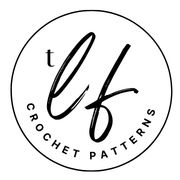


A few months ago I bought a set of Tunisian hooks which were wooden. As I was looking at them, I felt uneasy about the sizing. I used my husband’s micrometer to check the accuracy of the mm sizing. Sure enough some of them were off by as much as 0.4 mm. I returned them.
The factories during WWII discovered that seamstresses could determine the roundness of ball bearings with their fingers better than any machine they could build. So all the seamstresses were hired toward the war effort.
Wow, I did not know that about the seamstresses! That is an incredible little piece of information and I’m so glad you shared it.
My hubby is a history buff and he told me that years ago.
Love that!
Very good article. I have purchased so many, and found my “favs” . I probably have as many hooks as i have yarn stashes. So my question for you is=
Grips; rather than buy new i would like suggestions on either repairing old loose ones, or purchasing products that slip onto them.
Also, I have some skinny aluminum ones that NEED a grip. (ps wrapping elastics on handle is not a great solution LOL )
I tried shopping on amazon, might as well buy new again. Same thing when you go to the hook sites. Any dyi ideas?
thanks, love your site!
Aww thank you so much for all of your compliments. They’ve put a big smile on my face!
I think the best thing I’ve found for a “DIY” grip is actually a pencil grip like kiddo’s use in school. I have some aluminum hooks in the very small sizes and that has helped me some – It not only makes it squishy but also wider so it’s easier to hold and I’m not pinching as much. It’s not totally perfect but it works well for me. At the very least, it’s a cheapish option to try to see if it works for you. That way you wouldn’t have to do a big investment of crafting materials or even new hooks. I just don’t have the time really to learn how to do anything special like polymer clay but I know that’s very popular. You could try giving that a go, in that case you could shape it more to have a thumb rest. I think for repairing a grip, I’d likely get some glue and try to get it in between the grip and the aluminum (or other material) to get it to stay in place. I haven’t actually done that, though, just an idea of what I might do.
I hope this helps!